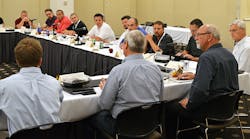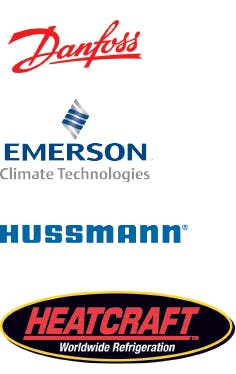Refrigeration Roundtable: Seeking Answers and Cooperation
ContractingBusiness.com continued its look at the changes surrounding commercial-use refrigerants and refrigeration equipment, during its most recent “Refrigeration Roundtable” summit, part of the successful Comfortech 2015 show in St. Louis, Sept. 15-17.
We again brought together experts from supermarkets, commercial refrigeration contracting firms and vendors, for informative discussion on changes facing the commercial refrigeration industry.
Some Background: In July 2016, the first EPA ruling takes effect, and will impact the following refrigeration systems:
• Retrofitted supermarket systems: R–404A, R–407B, R–421B, R–422A, R– 422C, R–422D, R–428A, R–434A, and R–507A.
• Retrofitted remote condensing units: R–404A, R–407B, R–421B, R– 422A, R–422C, R–422D, R–428A, R– 434A, and R–507A.
• Retrofitted vending machines: R– 404A and R–507A
• Retrofitted stand-alone retail food refrigeration equipment: R–404A and R–507A.
(A downloadable PDF of the entire ruling can be found online, at bit.ly.EPANewDelist)
With the growing interest carbon dioxide as a viable alternative refrigerant, we knew it was important to add carbon dioxide (CO2) to the discussion outline. What did or panelist think about the prospects for expanding CO2 in supermarket systems?
Frank Davis, director, facility engineering for Sprouts markets, sees a good future for CO2.
“It’s a great refrigerant, and I like the technology,” Davis said, and shared that Sprouts’s teams are testing it.
“The big issue is cost,” Davis continued. “It’s hard to justify that cost when you’re already purchasing a DX (direct expansion) system, and now you’re trying to sell a CO2 system to the business. As more end-users purchase it obviously that cost will come down. But that’s the biggest issue, as well as the related training. It is an issue in city locations as well as rural areas, which was discussed in our last article (see online: bit.ly/RR2016Part1).
Additionally, Davis added that not every contracting firm has adequate knowledge of CO2.
Jim Galehan, refrigeration and HVAC manager for Giant Eagle stores, said several Giant Eagle stores are using carbon dioxide secondary systems and they run very efficiently.
“It’s a good refrigerant, but the cost is prohibitive,” he said.
As the CO2 adaptation story continues in various degrees by various entities, Galehan said his teams are moving towards R-407A. R-407A was developed as a close match to R-22’s capacities and flow rates, making it well suited as an energy efficient retrofit for R-22 in medium and low temperature refrigeration systems for supermarket and food storage applications, but not for air conditioning systems or those with flooded evaporators. He agreed that it’s tough to keep up with the training associated with refrigerant changes, to say nothing of equipment.
“As OEMs, retailers and contractors, we can’t keep up,” he said. “That quick pace of change is something that, on the very front end, when you go back to what the EPA and DOE are trying to do as far as drafting regulations and eliminating pollution, that has to be on the front end of the proposals. We can’t keep up. It’s very difficult.”
Change Requires Testing
We asked about the industry’s lobbying efforts. Are they persistent enough? For example, Doug Young current chairman for The Air Conditioning, Heating and Refrigeration Institute (AHRI) has issued a call for more participation by manufacturers in the legislative process, if the HVACR industry expects any semblance of fair treatment by the government.
Ron Shebik, global product design manager for Hussmann Corp., said that kind of participation can indeed help.
“I spent a lot of time the last several years with both the Department of Energy, as well as the EPA, and we’re finally getting to a point, at least on the EPA side, where they are acknowledging that there needs to be some kind of joint effort between them and the DOE. When you put together a timeline, the two can’t be disjointed. They have to work together. Because, there is a burden on the retailers, and on the manufacturers, those who make the display coolers and walk-ins.”
Shebik added that he senses the EPA is fairly willing to work together towards reasonable change.
“We’re still trying to work with the DOE, to get them to realize that,” he said, and added that a government groups need to understand that, for every change they make, considerable testing is required.
“You just can’t pop out a product overnight. In some cases, it requires years of development,” he said.
Quentin Crowe, a Hussmann product manager, spoke of other issues related to regulatory relevance.
“If you look at the EPA’s and DOE’s regulation for walk-in boxes, you see that they set a standard. The DOE set a refrigerant standard and used the guideline for a refrigerant that was going to be obsolete. So, we have to meet energy guidelines of R-408. By the time the regulation went into effect, it’s going to be obsolete on the equipment. California’s Title 24 wants industry to move in a green direction, yet their own rule-making dictates that CO2 will be extremely uncompetitive.
“California’s also trying to conserve water, so they set this regulation, and it’s a battle to go back and forth.
“If we were just left alone to innovate, I think the industry would be much further ahead, and you’d see far more efficient equipment,” Crowe said.
Open or Shut Case?
The “door debate” continues. Jim Galehan said Giant Eagle is testing using swing-out doors on dairy cases in 18 stores in Columbus, Oh.
“These are dairy cases that are 10-years-old or newer. We’re assessing rack adjustments, superheat adjustments, and some valve change-outs with Hussmann modular coils, to see where we can land with energy savings. At this time, we see two percent (energy savings), plus electric utility rebates.”
Frank Davis of Sprouts added that Sprouts is also adding doors to dairy cases.
“We know there’s energy savings, but trying to sell it to the business, mainly the merchandisers is still a problem," he said.
Other initiatives by Sprouts that Davis shared include electronically commutated motors, night curtains, anti-sweat controls and LED lights. One LED light has a driver in the bulb.
Michael Lehtinen, director marketing for Heatcraft asked what he said is the most important question: “how do we accelerate the adoption of new technologies?”
“We talk about the pace of change for everything from refrigerants to lighting technologies to control strategies, and they’re evolving at a pace that doubles any adoption rate we’ve seen.”
Quentin Crowe said control manufacturers need to start offering open protocol controls. If not, manufacturers need to say, “we’re not going to use your product anymore; we’re going to develop our own, as is done in the air conditioning industry.”

